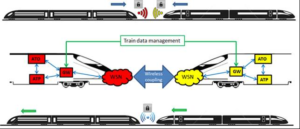The efficient use of a rail track is today limited by the minimum distance between trains that can be safely handled by a signalling, control, and train protection system (in Europe, for instance, the European Train Control System ETCS is widely used). Today, the control and protection of the trains is carried out by dedicated land-side infrastructure that relies on communication with the trains over wireless V2I and I2V data links (typically GSM-R is used in Europe).
The safety distance between trains – and thereby the capacity of a rail track – is mainly determined by:
With a reliable radio link that is able to transfer data directly between trains, an additional communication channel is made available that is able to handle time-critical events much better than a centralized system. Unexpected events or potentially dangerous situations on the track can be communicated directly to following or approaching trains. This allows (i) to take immediate action to mitigate potentially dangerous situations, and (ii) can increase the capacity of a rail track by effectively reducing the necessary safety distance between trains.
In this workpackage a reliable and low-latency V2V radio communication will be devised that allows an additional and direct communication channel between trains. This is a valuable supplement to the existing land-side communications with a centralized train control system. The developed radio modules will be integrated into a gateway (GW) that can be connected to the Train Control and Monitoring System. The gateways then can establish a trusted and secure communication channel between the trains and the exchange of data like position, speed, or critical events along the track is facilitated.
Another aspect of reliable and low-latency V2V communication addresses the composition of train sets. Today, trains sets are joined together by pneumatic, mechanical and electrical connections that have to be made manually. The shunting and coupling operations with trains pose high safety risks and are a significant cost factor, expending time and personnel. Furthermore, only compatible trains can be coupled with each other which puts limits on interoperability because the compositions to be joined must be, for instance, of the same model.
To overcome the previous constraints on train composition coupling, the trustable V2V communication link that is developed in this workpackage brings significant benefits. Data between two trains can be exchanged and movements of the trains can be negotiated and controlled in real-time. Over the wireless link, the trains exchange information on their composition, position, power drives, vehicle mass, and length. They also establish a control hierarchy so that one train can issue acceleration or break commands for the other train(s) in the virtual train set. This allows moving the coupled train set, which consists of two or more trains, without actually establishing a physical connection between them. The two coupled trains will be able to perform synchronous movements in a low-speed train manoeuvring mode that is provided by the Train Control Monitoring System (TCMS). For this application, the trains need to be equipped with a means for distance measurement. Based on the requirements that are determined in the beginning of the project a suitable distance measurement functionality (either optical, ultrasonic, cooperative or non-cooperative radar) will be integrated into the trains.

